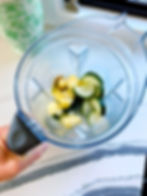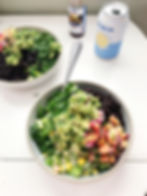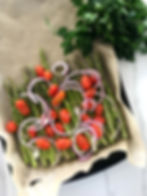20 Foods To Eat This Spring For Clean Eating [Complete Food List]
- Autumn Bates, CCN, MS, BS, CPT
- Mar 24, 2023
- 5 min read
Spring has officially sprung and you might be feeling the urge to spring clean your house, mind and maybe even your GI tract, too! Thankfully, spring is also loaded with fresh fruits and veggies that make eating delicious meals that support your goals super simple.
I know how easy it is to get into a rut with eating the same few ingredients every day. So today, I'm sharing 20 foods that you should experiment with this spring to help support your weight loss and wellness goals while also giving your taste buds a little excitement, too.
One thing that's important to note: this list contains fruits and veggies, but don't forget about your high quality sources of protein and fat! Protein should always be the staple of every meal to help stabilize blood sugar levels and support body recomposition goals. This is one of the concepts we practice with the Complete Intermittent Fasting Bundle to help thousands of men and women around the world tap into fat burning mechanisms and feel great again. Once you have your protein sorted, feel free to add in the plethora of spring ingredients from today's list to spice things up!

Apricots
One apricot is surprisingly low in sugar, coming in at only 3 grams per apricot. With any clean eating protocol, one of the aims should be keeping sugar content on the lower side (even from naturally occurring sugars, such as those in fruit). Too much sugar can slow down liver detoxification, lead to new fat creation (called de novo lipogenesis) and possibly even fatty liver disease. (1)
The naturally low sugar content of apricots make it a great addition to a clean eating diet. Try adding 1-2 sliced apricots to a bowl of greek yogurt and nuts for a satiating, low sugar breakfast (or break-fast, if you're following Intermittent Fasting.)
Collard Greens
Collard greens are naturally high in fiber and low in carbohydrates. Two cups of collard greens comes packed with 23% of your daily folate needs and 42% of your daily vitamin C needs. It also contains nearly 400% of your vitamin K1 needs (not to be confused with vitamin K2 which mostly comes from grass-fed dairy products and pasture raised eggs).
Try sautéing your collard greens with some butter and onions or use it as a wrap instead of bread.

Strawberries
This naturally low sugar fruit is a fan favorite with most people. It's also super easy to use as a topping for protein pancakes, cottage cheese bowls and greek yogurt. You can also replace your high sugar ice cream with naturally low sugar strawberries and freshly whipped cream.
Grab my strawberries and cream recipe HERE.
Radishes
Radishes can help mix up your salads by providing a slightly spicy crunch factor. I also love chopping it into thin strips and topping it on homemade tacos.

Pineapple
This light and tropical tasting fruit is perfect topped on greek yogurt bowls or blended into a protein smoothie. Depending on your carb sensitivity, you might want to stick to 1/2 cup fresh or frozen pineapple per day.
Try my Tropical Cucumber Smoothie featuring pineapple HERE.
Lemon
Lemons have been found to help aid in blood sugar stabilization, making it a great ingredient to squeeze into your water before eating a meal. I also love adding the zest and juice straight into my protein smoothies for a huge boost of flavor.

Cabbage
Have you ever tried sautéed cabbage? If not, you're missing out! Sautéed cabbage and onions makes an excellent veggie side dish to scrambled eggs. You won't even miss the toast!

Avocado
All these veggies are great, but in order to feel full and satisfied from your meal, it's important to get some high quality fat in there as well. Thankfully, avocado goes well with *pretty much* anything. I love making the SoCal Spicy Guac from my 21 Day Intermittent Fasting Program and topping it on tacos, cauliflower rice burrito bowls and scrambled eggs.
Checkout my 21 Day Intermittent Fasting Program HERE.
Kiwi
One kiwi has around 8 grams of carbohydrates, making it a fairly low sugar fruit. You can add sliced kiwi to your favorite spring time smoothie bowl.
Celery
Celery provides an amazing crunch, making it the perfect swap for refined crackers and chips. Try loading up your celery with cottage cheese and peanut butter for a high protein snack. And don't forget about all the delicious meals you can make with celery! Soups and stews galore.

Lettuce
It's officially salad season! Just don't forget to pair your salad with high quality sources of fat and protein to make it a complete meal. One of my favorites is hard boiled eggs with avocado. You can also load up romaine lettuce slices with chicken salad for a crunchy wrap at lunch.

Herbs
Herbs can completely elevate and transform any meal - they really should be used more often! A simple boring salad can turn into a mediterranean inspired tabbouleh salad with just a few herb additions. Try fresh parsley, mint and cilantro.
Garlic and Onions
These alliums help to add flavor to any meal. Plus, garlic has studied antibacterial properties to help keep your immune system boosted throughout the Spring season.(2) Try sautéing onions with scrambled eggs or adding a clove of garlic to your homemade salad dressing.
Mushrooms
Shiitake, portobello, crimini, oyster... the options are nearly endless with fresh mushrooms! I personally like lightly grilling portobello mushrooms and using them as a "bun" for burgers.
Peas
A half cup of cooked peas has nearly 4 grams of fiber and only 8 grams net carbs. Peas also contain a mix of B vitamins, vitamin K1 and Manganese. I use green peas mixed with pesto in the Green Monster recipe from my Level Up Guide. Just remember to pair it with about 4-6 oz. of complete protein, like beef burgers, roasted chicken or grilled salmon.
Check out my Level Up Guide HERE.

Asparagus
Asparagus is naturally very low carb and packed with nutrients such as vitamin K1, folate and vitamin C. You can toss asparagus on the grill or load them up in the oven with some of your other seasonal favorites, like tomatoes, onions and garlic.

Kale
Kale has been the darling superfood for a nearly a decade now. To maximize the nutrient value of your kale, try and opt for buying it from a farmers market. Typically farmers market purchased fruits and veggies were picked the day before and therefore haven't "lost" as much of their vitamin potential as those you might purchase from the grocery store.
Pro tip: don't skip the "massage" step in kale salad recipes. This actually makes a big difference to the flavor and how easily your body digests it.
Broccoli
Cruciferous veggies like broccoli and cauliflower are loaded with phase 2 liver detox supporting nutrients. This is why we prioritize using broccoli in the 7 Day Detox!
Try roasting chopped broccoli in the oven with olive oil and sea salt. Or you can test out the Crunch Broccoli Salad (pictured above) from my 7 Day Detox Program.
Carrots
Carrots are often mistaken as "high in sugar", but they actually have an incredibly low glycemic load of 2. For reference, white rice has a whopping glycemic load of 35! (3) I love adding shredded carrots to my salad or roasting carrots with onions and moroccan seasonings.
Turnips
Have you used turnips before? Don't knock it til you've tried it! Turnips are in the same cruciferous family as Brussels sprouts and broccoli. Something unique to turnips is that you can eat the root and the leaves - in fact, the leaves are even more packed with vitamins than the root! I would definitely recommend getting turnips from the farmers market if you're planning on using the greens. I've found turnip greens at the grocery store are often wilted and sad (probably because they aren't as fresh as farmers market varieties).
Unlock the Intermittent Fasting tips, meal plans and recipes that have helped thousands of men and women around the world with the Complete Intermittent Fasting Bundle!
100+ recipes, 8 weeks of meal planning, science-backed Intermittent Fasting tips and so much more!
Head over HERE to get started!
❤️ Autumn

Autumn Elle Nutrition









